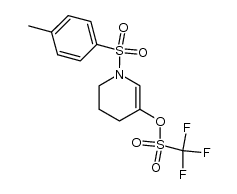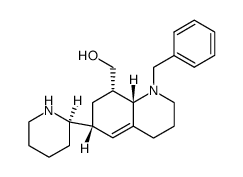Aloperine

Aloperine structure
|
Common Name | Aloperine | ||
|---|---|---|---|---|
| CAS Number | 56293-29-9 | Molecular Weight | 232.365 | |
| Density | 1.1±0.1 g/cm3 | Boiling Point | 367.7±37.0 °C at 760 mmHg | |
| Molecular Formula | C15H24N2 | Melting Point | 69 - 71ºC | |
| MSDS | Chinese USA | Flash Point | 155.8±17.5 °C | |
| Symbol |

GHS07 |
Signal Word | Warning | |
Use of AloperineAloperine is an alkaloid in sophora plants such as Sophora alopecuroides L, which has shown anti-cancer, anti-inflammatory and anti-virus properties[1]. Aloperine is widely used to treat patients with allergic contact dermatitis eczema and other skin inflammation in China[2]. Aloperine induces apoptosis and autophagy in HL-60 cells[1]. |
| Name | aloperine |
|---|---|
| Synonym | More Synonyms |
| Description | Aloperine is an alkaloid in sophora plants such as Sophora alopecuroides L, which has shown anti-cancer, anti-inflammatory and anti-virus properties[1]. Aloperine is widely used to treat patients with allergic contact dermatitis eczema and other skin inflammation in China[2]. Aloperine induces apoptosis and autophagy in HL-60 cells[1]. |
|---|---|
| Related Catalog | |
| In Vitro | Aloperine (1-20 mM; 24 hours) gives growth-inhibitory IC50 values in cancer cells ranges from 0.04 to 1.36 mM, the IC50 values in HL-60, U937, K562, EC109, A549 and HepG2 cells are 0.04, 0.27, 0.36, 1.11, 1.18 and 1.36 mM,respectively[1]. Aloperine (1-20 mM; 24 hours) induces apoptosis and decreases bcl-2 expression in HL-60 cells[1]. Aloperine (20–100 mM; 18 hours) induces autophagy and formation of acidic vacuole in HL-60 cells[1]. |
| References |
| Density | 1.1±0.1 g/cm3 |
|---|---|
| Boiling Point | 367.7±37.0 °C at 760 mmHg |
| Melting Point | 69 - 71ºC |
| Molecular Formula | C15H24N2 |
| Molecular Weight | 232.365 |
| Flash Point | 155.8±17.5 °C |
| Exact Mass | 232.193954 |
| PSA | 15.27000 |
| LogP | 3.21 |
| Vapour Pressure | 0.0±0.8 mmHg at 25°C |
| Index of Refraction | 1.583 |
| Storage condition | -20℃ |
CHEMICAL IDENTIFICATION
HEALTH HAZARD DATAACUTE TOXICITY DATA
|
|
Two Small Molecules Block Oral Epithelial Cell Invasion by Porphyromons gingivalis.
PLoS ONE 11 , e0149618, (2016) Porphyromonas gingivalis is a keystone pathogen of periodontitis. One of its bacterial characteristics is the ability to invade various host cells, including nonphagocytic epithelial cells and fibrobl... |
|
|
Aloperine executes antitumor effects against multiple myeloma through dual apoptotic mechanisms.
J. Hematol. Oncol. 8 , 26, (2015) Aloperine, a natural alkaloid constituent isolated from the herb Sophora alopecuroides displays anti-inflammatory properties in vitro and in vivo. Our group previously demonstrated that aloperine sign... |
|
|
[Simultaneous determination of 7 alkaloid in herba Sophorae Alopecuroidis by HPLC].
Zhongguo Zhong Yao Za Zhi 36(11) , 1483-6, (2011) To establish a method for determination of 7 alkaloid in Herba Sophorae Alopecuroidis by HPLC.X-Brige C18 (4.6 mm x 200 mm, 5 microm) column was used with acetonitriles-0.05 mol x L(-1) KH2PO4 solutio... |
| ALOPERIN |
| ALLOPTERIN |
| Aloperine,orMosanine |
| (1R,2S,9R,10R)-3,15-Diazatetracyclo[7.7.1.0.0]heptadec-7-ene |
| 6,13-Methano-2H-dipyrido[1,2-a:3',2'-e]azocine, 1,3,4,6,6a,7,8,9,10,12,13,13a-dodecahydro-, (6R,6aR,13R,13aS)- |
 CAS#:220384-56-5
CAS#:220384-56-5![(6R,7R,13R,14R,15S)-14-hydroxy-1-(p-toluenesulfonyl)-tetradecahydro-6,13-methano-dipyrido[1,2-a,3',2'-e]azocin-12-one Structure](https://image.chemsrc.com/caspic/098/220384-61-2.png) CAS#:220384-61-2
CAS#:220384-61-2 CAS#:792937-20-3
CAS#:792937-20-3 CAS#:792937-19-0
CAS#:792937-19-0
